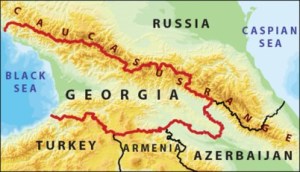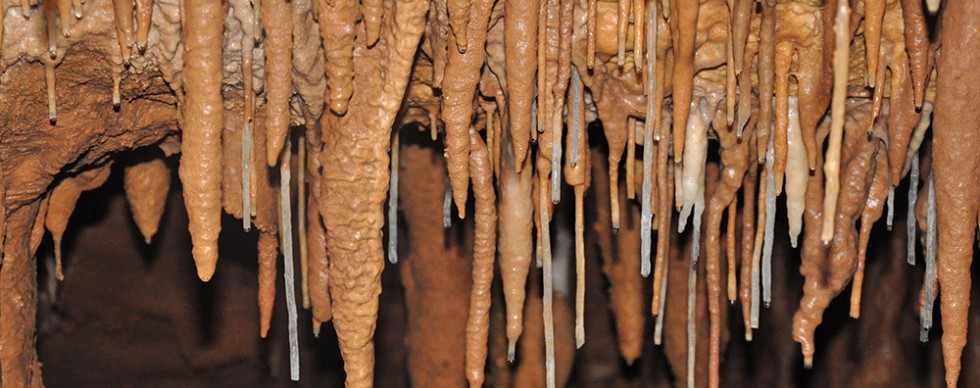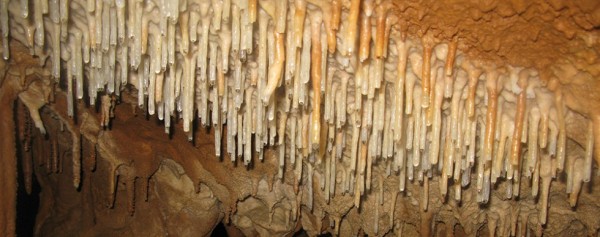Georgia is a mountainous country located in the neck of the Caucasus mountain range among the Black and Caspian Seas. in the western part of Georgia from the coastal zone of the Black Sea to the summits of Caucasus in tens of kilometers almost all natural zones are represented.
The limestone zone of Georgia is extended along the southern slope of the Caucasus at a distance of 325 km from the Psou River to the east of the Ertso Lake vicinities, and vertically it reaches about 2705 m above sea level (Speleologists Peak). Its total area is 4475 sq. km, and makes almost 7% of the whole territory of Georgia. Nowadays, the number of surveyed karst caves in Georgia exceeds 1500.
Especially should be mentioned the “Geography of Georgia” of encyclopedic content written by Vakhushti Bagrationi – the famous Georgian geographer of 18th century, which contains the interesting information on karst caves of Georgia. It can be said that the surveying of the cave- cavities of Georgia begins from the epoch of Vakhushti Bagrationi.
 Cave-cavities of Georgia, as the phenomena of nature, from time immemorial attracted the attention of various researchers. They are often mentioned in the ancient Georgian annals and literature sources (Juansheri, Rustaveli, Sulkhan Saba Orbeliani, etc.), as well as in the works and compositions of foreign researchers and travelers (Strabo, Arcangelo Lambert, Frederic Dubois De Montpereux, Édouard-Alfred Martel, etc.).
Cave-cavities of Georgia, as the phenomena of nature, from time immemorial attracted the attention of various researchers. They are often mentioned in the ancient Georgian annals and literature sources (Juansheri, Rustaveli, Sulkhan Saba Orbeliani, etc.), as well as in the works and compositions of foreign researchers and travelers (Strabo, Arcangelo Lambert, Frederic Dubois De Montpereux, Édouard-Alfred Martel, etc.).
In 1958, by the initiative of Academician Alexander Javakhishvili and Professor Levan Maruashvili the Laboratory of Karstology and Speleology was created in the Vakhushti Bagrationi Institute of Geography of Georgia, the Head of which was appointed the Dr. Shalva Kipiani and they laid the foundation for the systematic and well-planned research of karst caves in Georgia. In a short time period the “Cadastre of karst caves of Georgia” was published in 1966, in which up to 300 karst caves were registered at that time. Each following expedition season brought new discoveries; the knowledge about the karst caves was completed and enriched, which was followed by the new edition of the “Cadastre of karst caves of Georgia” (Zurab Tatashidze, Kukuri Tsikarishvili and Jumber Jishkariani, 2009), which already includes the data of more than 1300 karst cave-abysses. Their total length exceeds 250 km and the depth exceeds 63,5 km.
Karst caves are our “gold fund”. Researchers fixed the living and activity remains of primitive humans into many caves. Kudaro, Tsona, Tsutskhvati, Dzudzuana and Jruchula caves are the archaeological monuments of world importance.
The expected karsting depth exceeds 4000 meters. Due to such etalon conditions of karst formation, the Georgia’s mountain karst is one of the unique regions of the Earth. It can be noted that the first three deepest abysses in the world are located in Georgia’s high mountainous limestone massifs of Bzipi and Arabika: the Krubera abyss, which is a world’s deepest abyss (2197 m), was discovered by the Georgian researchers in 1960 by the leadership of Professor Levan Maruashvili, the Sarma (1830m) and Ilyuzia-tovliani-mezheni (1753m) abysses. Therefore, the world record of depth penetration is in Georgia, which was established in the Krubera (Voronja) abyss by the group of the Ukrainian Speleological Association.
 In 1961, the speleologists from the Vakhushti Bagrationi Institute of Geography (Shalva Kipiani, Surab Tatashidze, Arsen Okrojanashvili, Boris Gergedava), with local resident (Givi Smiri), discovered and explored Akhali Athoni cave, which became one of the important tourism destinations in Europe.
In 1961, the speleologists from the Vakhushti Bagrationi Institute of Geography (Shalva Kipiani, Surab Tatashidze, Arsen Okrojanashvili, Boris Gergedava), with local resident (Givi Smiri), discovered and explored Akhali Athoni cave, which became one of the important tourism destinations in Europe.
In the beginning of the 80s of the last century, the significant speleological discoveries have been made in Tskaltubo limestone massif, where the expedition group of the Vakhushti Bagrationi Institute of Geography (J. Jishkariani, V. Kapanadze, A. Jamrishvili, T. Kobulashvili and K. Nizharadze) discovered the multi-entry Tskaltubo (Prometheus) cave system of labyrinth type, the total length of the partly water corridors of which exceeded 15 km.
The Researchers of the Vakhushti Bagrationi Institute of Geography (Zurab Tatashidze, Levan Maruashvili, Shalva Kipiani, Jumber Jishkariani, Arsen Okrojanashvili, Boris Gergedava, Omar Erkomaishvili, Tamaz Kiknadze, Kukuri Tsikarishvili, Givi Gigineishvili, Davit Simonishvili, Zaza Lezhava, Kiazo Rakviashvili, Tamaz Kobulashvili, Amiran Jamrishvili, Vakhtang Kapanadze, Giorgi Geladze, Merab Gongadze, Lasha Asanidze, Giorgi Dvalashvili, etc.) have the great contribution in the development of Speleological Science in Georgia.
In different years the scientists of the Vakhushti Bagrationi Institute of Geography carried out the important works for discovery and scientific study of Akhali Athoni, Sataplia, Tskaltubo (Prometheus) and other cave systems, which later were put as a foundation to tourist development of these beautiful speleological objects. Together with the Georgian speleologists the Ukrainian, Russian, French, Czech, Polish, Lithuanian, Austrian, Slovenian and speleo-expedition groups of other countries made a significant contribution in the discovery and study of the karst caves and abysses of Georgia.
Nowadays the speleological group of the Vakhushti Bagrationi Institute of Geography actively cooperates with the Speleological – Diving Club of the Lithuanian Speleological Association. It must be noted that important discoveries have been implemented in Georgia during the last two years, which is fixed in the international database of new geographical discoveries.
Speleological group of Vakhushti Bagrationi Institute of Geography continues scientific researches in this field. We offer the cooperation in this activity the organizations and speleological groups interested in study of the karst of Georgia.

